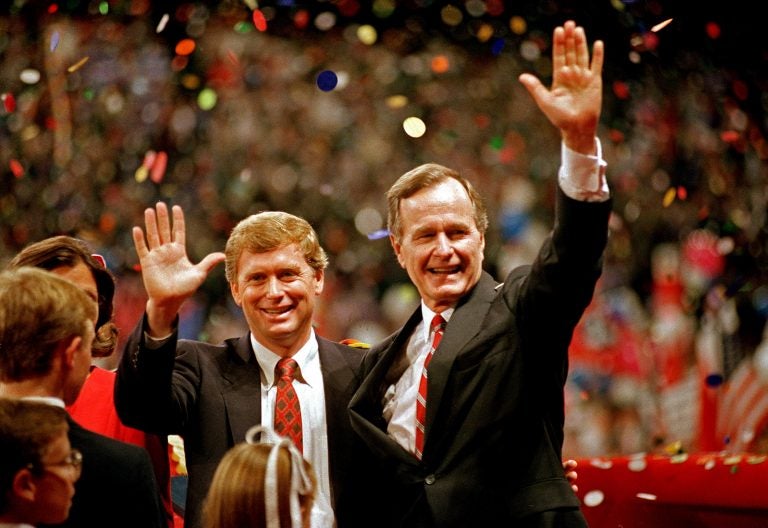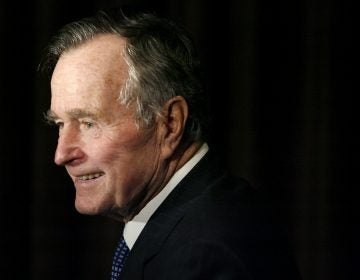Before he was ‘kinder, gentler,’ Poppy Bush pioneered TV ad lies
What Bush did during that 1988 campaign - and what we in the press allowed him to get away with - can't be whitewashed.

FILE - In this Aug. 18, 1988 file photo, Republican presidential candidate, Vice President George H.W. Bush, right, and his running mate Sen. Dan Quayle, R-Ind., wave to the assembly of the Republican National Convention in New Orleans after their acceptance speeches for the presidential and vice-presidential nomination. (AP Photo/J. Scott Applewhite, File)
Thirty years ago at The Philadelphia Inquirer, in the early autumn of ’88, I was handed my first assignment as a political writer. The presidential candidates, Vice President George H. W. Bush and Massachusetts Gov. Michael Dukakis, were saturating the airwaves with campaign ads – to an extent never seen before – and I analyzed the imagery in a dozen articles.
It was obvious, right from the start, that Bush was sloshing in the sewer. His ad campaign – crafted by two of the GOP’s most notorious junkyard dogs, Roger Ailes (future founder of Fox News), and Lee Atwater (the preeminent race-baiter of his era) – broke new ground for TV demagoguery and foreshadowed the lying toxicity that is now routine.
I’ll stipulate that Bush, now dead at 94, was a well-mannered nice guy in life. During his ’89 Inaugural speech, he promised a “kinder, gentler” America, and he indeed tried to set a tone that’s the antithesis of what we’re forced to endure today. I even contended, in a column three years ago, that he was an underrated president.
But what he did during that 1988 campaign – and what we in the press allowed him to get away with – can’t be whitewashed. For those of us old enough to remember, it was truly a disgusting performance. What he did doesn’t jibe with all the current hagiography, but so be it. History was made that autumn. Bush’s TV ads lied so relentlessly that the press began to realize, for the first time, that its traditional rules – “balance” and “objectivity” – were inadequate to the task at hand. Thanks to Bush, the practice of fact-checking was born.
Alas, it didn’t happen very often. Most political reporters, shackled to the traditional rules, generally focused on the “negative” tone of the ads and left the impression that both candidates were throwing mud in equal proportions (in truth, Bush’s share was roughly 90 percent). Parsing the falsity of the ads was still considered “subjective,” and it only at the close of the campaign when most reporters wish they had fact-checked far more often. David Broder, the Washington Post legend, wrote about that in January ’89. He quoted a Post colleague, Lloyd Grove: “I think we probably didn’t pay much attention (to the accuracy issue) early on.” And he quoted me: “When it was over, I was kicking myself a bit for not doing more in that area.”
What did Bush lie about, in TV ads that sank into the public consciousness? Let us count the ways.
Most infamously, one ad (produced by a Bush-allied conservative group) contended that Dukakis was a soft-on-crime governor who had furloughed a black inmate, Willie Horton, who in turn had taken advantage of his freedom by raping a white woman. This was buttressed by a second Bush ad, which asserted that he had allowed 268 first-degree murderers to escape from the furlough program. In truth (rarely reported), the furlough program had been created by Dukakis’ Republican predecessor; only 4 of the furloughed inmates had murder convictions; most were petty criminals who had merely reported back to prison two hours late; and none of the inmates were at large. (Willie Horton did rape a woman. But Bush, on the campaign trail, repeatedly stated that Horton had murdered a woman.)
Other Bush ads falsely claimed that Dukakis was soft on national defense: “Michael Dukakis has opposed virtually every defense system we have developed.” In truth (rarely reported), Dukakis supported the Stealth bomber, the Trident II submarine, the SSN21 Seawolf attack submarine, a new ballistic missile called the D5, and a slew of other weapons. I managed to fact-check those Bush ads late in the campaign, but under the rules of that era, I couldn’t report that his ads were full of “lies.” The editors OK’d the phrase “dubious credibility.”
Other Bush ads falsely painted Dukakis as a polluter who had dirtied Boston Harbor; one of the visuals showed a sign reading, “Danger/Radiation Hazard/No Swimming.” In truth (rarely reported), Dukakis in 1986 had created a new agency to clean up the harbor at a cost of $6 billion – and that President Reagan in 1987 had vetoed a Clean Water Act that would’ve helped finance a harbor cleanup. And in truth (rarely reported) the sign in the ad, warning about the danger of radiation, was not posted at Boston Harbor. It was appeared decades earlier at a Navy yard where nuclear subs were often repaired.
The press’ sporadic fact-checking efforts could not keep pace with the Bush campaign’s lies.But there was general agreement, after the election, that fact-checking should become more routine. Even the strategists in both parties called on the press to do it. Democratic adviser Robert Squier told an audience of political reporters, “When a candidate says something that is untrue, say so. Don’t stand on the sidelines. Be a referee.” And Republican adviser Dan Sipple said, “If reporters don’t analyze the truth and falsity of the ads, it’s bastardizing the role of the press, which is to inform.”
In subsequent decades, we in the press have often shirked our responsibility – most infamously, during the prelude to junior Bush’s disastrous Iraq war – but senior Bush and his ad-makers essentially taught us that we should be arbiters of truth, not stenographers in the service of lies. The fact-checking industry that flourishes today was birthed in the sewer of 1988. Thanks, Poppy!
WHYY is your source for fact-based, in-depth journalism and information. As a nonprofit organization, we rely on financial support from readers like you. Please give today.




